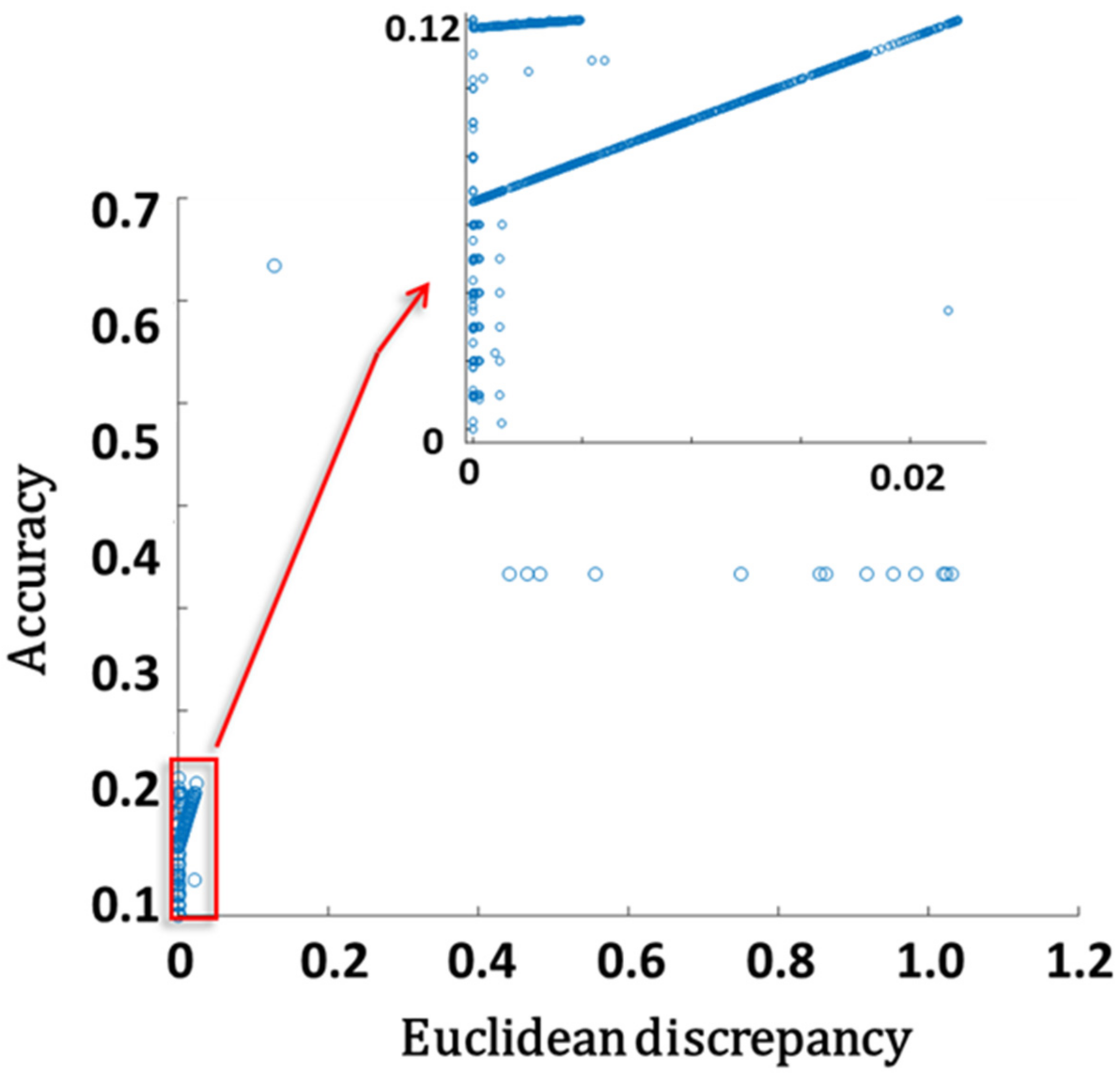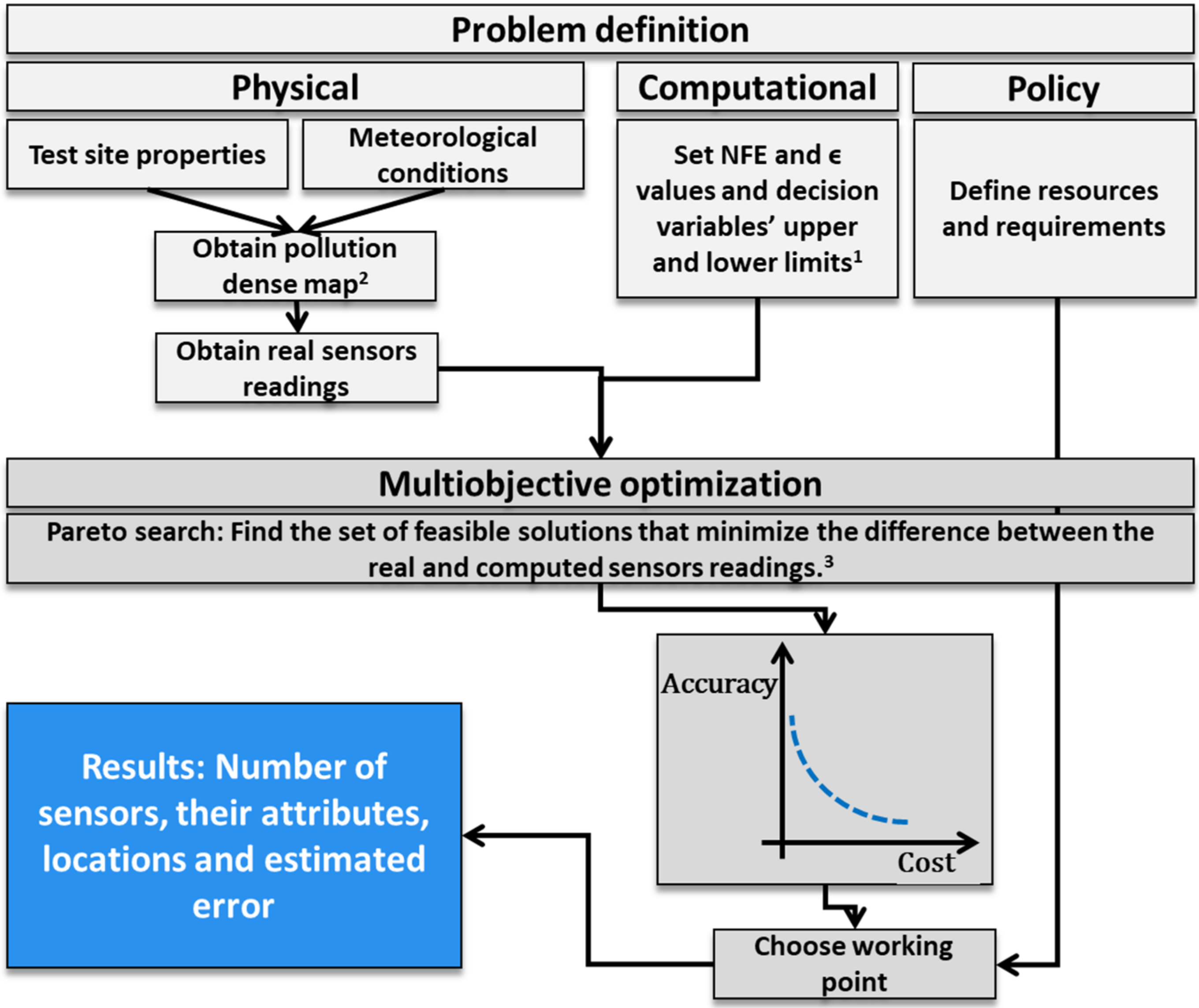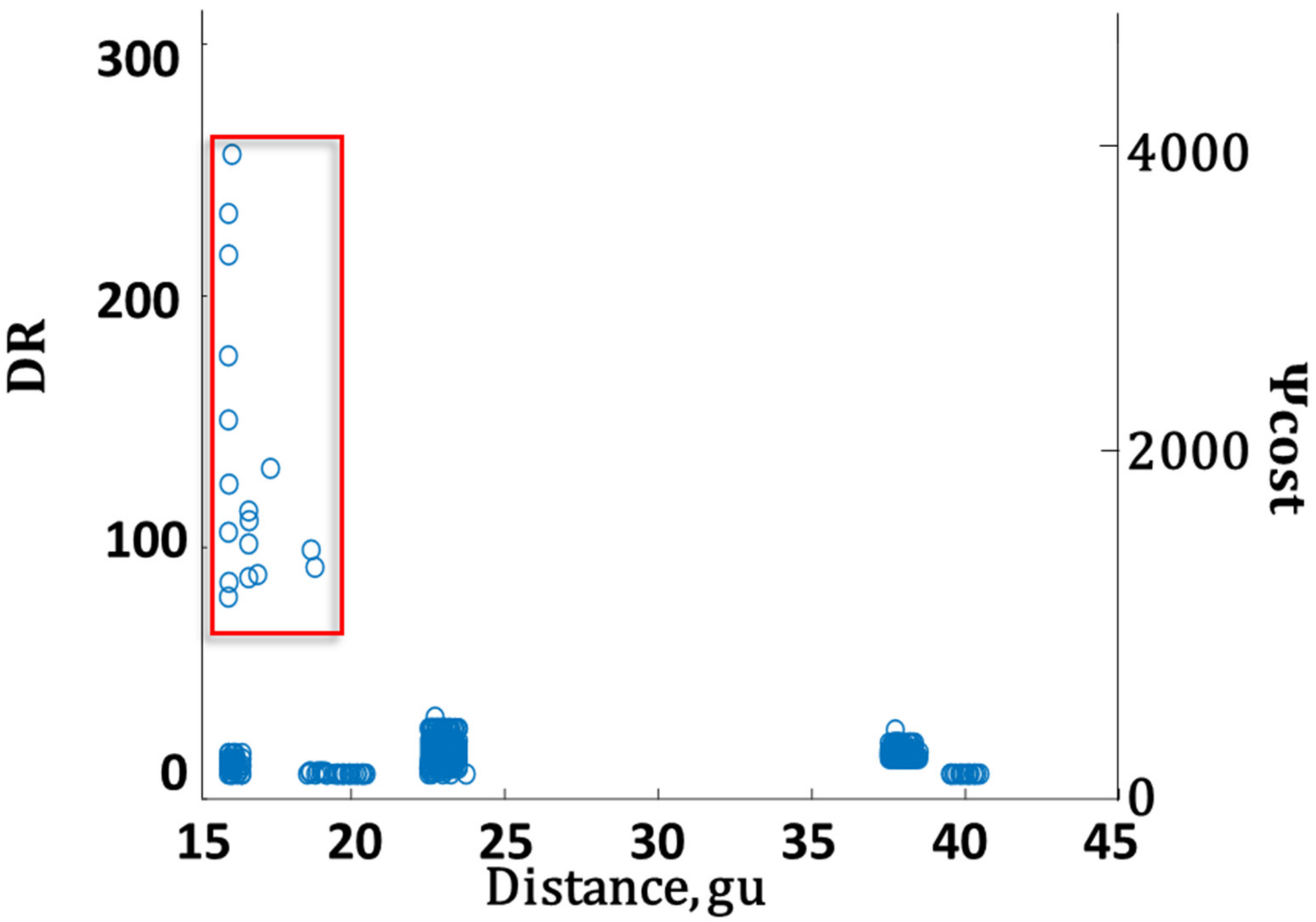Optimal Wireless Distributed Sensor Network Design and Ad-Hoc Deployment in a Chemical Emergency Situation
Abstract
:1. Introduction
1.1. Literature Review
1.2. Motivation and Innovation
- Defining optimal sensor locations.
- Identifying a match between sensor attributes and the emergency problem at hand.
- Estimating the possible errors deriving from the sensor attributes.
2. Methodology
2.1. Problem Formulation
2.2. Test Site
2.3. Solving the Optimization Problem
3. Results and Discussion
3.1. High-End Sensor Array
3.2. Practical Sensor Array
3.3. Resiliency to Changes in Problem Conditions
3.3.1. The Effect of a Reduction in the Number of Detectors and Their Attributes
3.3.2. Varying Leak Rates
4. Conclusions
Author Contributions
Funding
Data Availability Statement
Conflicts of Interest
Appendix A. The Graz Lagrangian Model—GRAL
| Parameter | Value | Units | |
|---|---|---|---|
| Operational parameters | Operation duration | 3600 | s |
| Dispersion time | 1200 | s | |
| Particles per second | 200 | 1/s | |
| Source Parameters | Emission rate | 10 | kg/s |
| Source diameter | 0.6 | m | |
| Exit temperature | 353 | K | |
| Emitted gas | CO | ||
| Deposition | No | ||
| Exit velocity | 6 | m/s | |
| Height | 10 | m | |
| Meteorology | Wind direction | West | |
| Wind velocity | 2 | m/s | |
| Atmospheric stability class | C | ||
| Surface roughness | 0.2 | m | |
| Roughness of building walls | 0.01 | m | |
| Horizontal grid resolution | 5 | m | |
| Vertical thickness of the first layer | 2 | m | |
| Vertical stretching factor | 1.01 | ||
| Number of cells in the z-direction | 40 | ||
| Min/max number of iterations | 100/500 |
Appendix B. Additional Results
- The tradeoff between cost and accuracy, a zoom-in view.

- The relationship between computed accuracy (ΨErr) and the Euclidean discrepancy

- The effect of MDL on the quantification and detection range

References
- Murvay, P.S.; Silea, I. A survey on gas leak detection and localization techniques. J. Loss Prev. Process Ind. 2012, 25, 966–973. [Google Scholar] [CrossRef]
- Sandberg, C.; Holmes, J.; McCoy, K.; Koppitsch, H. Application of a continuous leak detection system to pipelines and associated equipment. IEEE Trans. Ind. Appl. 1988, 25, 241–244. [Google Scholar] [CrossRef]
- Guo, K.; Yang, P.; Guo, D.H.; Liu, Y. Gas Leakage Monitoring with Mobile Wireless Sensor Networks. Procedia Comput. Sci. 2018, 154, 430–438. [Google Scholar] [CrossRef]
- Somov, A.; Baranov, A.; Spirjakin, D.; Spirjakin, A.; Sleptsov, V.; Passerone, R. Deployment and evaluation of a wireless sensor network for methane leak detection. Sens. Actuators A Phys. 2013, 202, 217–225. [Google Scholar] [CrossRef]
- Kendler, S.; Zuck, A. The Challenges of Prolonged Gas Sensing in the Modern Urban Environment. Sensors 2020, 20, 5189. [Google Scholar] [CrossRef]
- Zuck, A.; Sharabi, H.; Kendler, S. A highly efficient dust removal module for hazardous materials detector–development and testing using a laboratory setup. Int. J. Environ. Anal. Chem. 2019, 101, 1331–1346. [Google Scholar] [CrossRef]
- Zuck, A.; Sharabi, H.; Kendler, S. Detection of hazardous vapours in a dusty environment–development of a protective module for chemical sensor using a laboratory setup for systematically simulating realistic conditions. Int. J. Environ. Anal. Chem. 2020, 100, 134–151. [Google Scholar] [CrossRef]
- Kanaroglou, P.S.; Jerrett, M.; Morrison, J.; Beckerman, B.; Arain, M.A.; Gilbert, N.L.; Brook, J.R. Establishing an air pollution monitoring network for intra-urban population exposure assessment: A location-allocation approach. Atmos. Environ. 2005, 39, 2399–2409. [Google Scholar] [CrossRef]
- Cooper, L. Location-Allocation Problems. Oper. Res. 1963, 11, 331–343. [Google Scholar] [CrossRef]
- Legg, S.W.; Wang, C.; Benavides-Serrano, A.J.; Laird, C.D. Optimal gas detector placement under uncertainty considering Conditional-Value-at-Risk. J. Loss Prev. Process Ind. 2013, 26, 410–417. [Google Scholar] [CrossRef]
- Ndam Njoya, A.; Abdou, W.; Dipanda, A.; Tonye, E. Optimization of sensor deployment using multi-objective evolutionary algorithms. J. Reliab. Intell. Environ. 2016, 2, 209–220. [Google Scholar] [CrossRef] [Green Version]
- Lepley, J.J.; Lloyd, D.R.; Robins, A.; Rudd, A.; Wilks, A. Dynamic sensor deployment for the monitoring of chemical releases in urban environments (DYCE). Chem. Biol. Radiol. Nucl. Explos. Sens. XII 2011, 8018, 801812. [Google Scholar] [CrossRef]
- Marjovi, A.; Marques, L. Optimal spatial formation of swarm robotic gas sensors in odor plume finding. Auton. Robots 2013, 35, 93–109. [Google Scholar] [CrossRef] [Green Version]
- Rohi, G.; Ejofodomi, O.; Ofualagba, G. Autonomous monitoring, analysis, and countering of air pollution using environmental drones. Heliyon 2020, 6, e03252. [Google Scholar] [CrossRef] [PubMed] [Green Version]
- Girma, A.; Bahadori, N.; Sarkar, M.; Tadewos, T.G.; Behnia, M.R.; Mahmoud, M.N.; Karimoddini, A.; Homaifar, A. IoT-enabled autonomous system collaboration for disaster-area management. IEEE/CAA J. Autom. Sin. 2020, 7, 1249–1262. [Google Scholar] [CrossRef]
- Lerner, U.; Hirshfeld, O.; Fishbasin, B. Optimal deployment of a heterogeneous air quality sensor network. J. Environ. Inform. 2019, 34, 99–107. [Google Scholar] [CrossRef] [Green Version]
- Kendler, S.; Nebenzal, A.; Gold, D.; Reed, P.M.; Fishbain, B. The effects of air pollution sources / sensor array configurations on the likelihood of obtaining accurate source term estimations. Atmos. Environ. 2021, 246, 117754. [Google Scholar] [CrossRef]
- Nebenzal, A.; Fishbain, B.; Kendler, S. Model-based dense air pollution maps from sparse sensing in multi-source scenarios. Environ. Model. Softw. 2020, 128, 104701. [Google Scholar] [CrossRef]
- Honeycutt, W.T.; Ley, M.T.; Materer, N.F. Precision and limits of detection for selected commercially available, low-cost carbon dioxide and methane gas sensors. Sensors 2019, 19, 3157. [Google Scholar] [CrossRef] [Green Version]
- Kendler, S.; Zifman, A.; Gratziany, N.; Zaltsman, A.; Frishman, G. A new method and apparatus for on-site detection of trace levels of chemical warfare agents. Anal. Chim. Acta 2005, 548, 58–65. [Google Scholar] [CrossRef]
- Rafiei, M.; Sturm, P.J. Modeling of carbon monoxide dispersion around the urban tunnel portals. Glob. J. Environ. Sci. Manag. 2018, 4, 359–372. [Google Scholar] [CrossRef]
- Berchet, A.; Zink, K.; Oettl, D.; Brunner, J.; Emmenegger, L.; Brunner, D. Evaluation of high-resolution GRAMM-GRAL (v15.12/v14.8) NOx simulations over the city of Zürich, Switzerland. Geosci. Model Dev. 2017, 10, 3441–3459. [Google Scholar] [CrossRef] [Green Version]
- Oettl, D.; Sturm, P.; Almbauer, R. Evaluation of GRAL for the pollutant dispersion from a city street tunnel portal at depressed level. Environ. Model. Softw. 2005, 20, 499–504. [Google Scholar] [CrossRef]
- Alfonsi, G. Reynolds-averaged Navier-Stokes equations for turbulence modeling. Appl. Mech. Rev. 2009, 62, 040802. [Google Scholar] [CrossRef]
- Chen, H.C.; Patel, V.C.; Ju, S. Solutions of Reynolds-averaged Navier-Stokes equations for three-dimensional incompressible flows. J. Comput. Phys. 1990, 88, 305–336. [Google Scholar] [CrossRef]
- Hadka, D.; Reed, P. Borg: An Auto-Adaptive Many-Objective Evolutionary Computing Framework. E Comput. 2013, 21, 231–259. [Google Scholar] [CrossRef] [PubMed]
- Hadka, D.; Reed, P. Large-scale parallelization of the Borg multiobjective evolutionary algorithm to enhance the management of complex environmental systems. Environ. Model. Softw. 2015, 69, 353–369. [Google Scholar] [CrossRef] [Green Version]
- Burke, E.K.; Gendreau, M.; Hyde, M.; Kendall, G.; Ochoa, G.; Özcan, E.; Qu, R. Hyper-heuristics: A survey of the state of the art. J. Oper. Res. Soc. 2013, 64, 1695–1724. [Google Scholar] [CrossRef] [Green Version]
- Aharoni, R.; Arielly, R.; Peri, D.; Zuck, A.; Gilad, N.; Cohen, S.; Kendler, S. Gas concentration mapping using sample pooling with a single detector. IEEE Sens. Lett. 2021, 5, 1–4. [Google Scholar] [CrossRef]






| Decision Variable | Lower Bound | Upper Bound | Units |
|---|---|---|---|
| Leak rate | 0 | 10 | kg/s |
| Number of detectors | 16 | 17 | |
| Detector array distance | 15 | 45 | Grid units (1 gu = 50 m) |
| MDL | 0.1 | 3 | kg/m3 |
| DR | 10 | 300 |
Publisher’s Note: MDPI stays neutral with regard to jurisdictional claims in published maps and institutional affiliations. |
© 2022 by the authors. Licensee MDPI, Basel, Switzerland. This article is an open access article distributed under the terms and conditions of the Creative Commons Attribution (CC BY) license (https://creativecommons.org/licenses/by/4.0/).
Share and Cite
Kendler, S.; Fishbain, B. Optimal Wireless Distributed Sensor Network Design and Ad-Hoc Deployment in a Chemical Emergency Situation. Sensors 2022, 22, 2563. https://doi.org/10.3390/s22072563
Kendler S, Fishbain B. Optimal Wireless Distributed Sensor Network Design and Ad-Hoc Deployment in a Chemical Emergency Situation. Sensors. 2022; 22(7):2563. https://doi.org/10.3390/s22072563
Chicago/Turabian StyleKendler, Shai, and Barak Fishbain. 2022. "Optimal Wireless Distributed Sensor Network Design and Ad-Hoc Deployment in a Chemical Emergency Situation" Sensors 22, no. 7: 2563. https://doi.org/10.3390/s22072563
APA StyleKendler, S., & Fishbain, B. (2022). Optimal Wireless Distributed Sensor Network Design and Ad-Hoc Deployment in a Chemical Emergency Situation. Sensors, 22(7), 2563. https://doi.org/10.3390/s22072563







